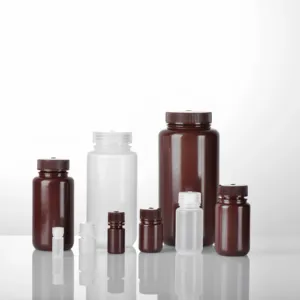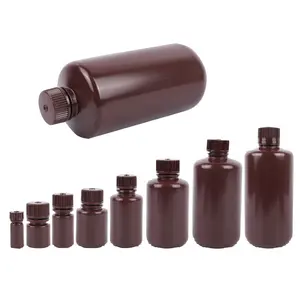
4ml 8ml 15ml 30ml 50ml 60ml 125ml 250ml 500ml 600ml 1L Plastic HDPE/PP Wide Mouth Reagent Bottle For Laboratory


2024 New Chemical Reagent Bottle 4ml-1000ml 50ml Plastic HDPE PP Clear Amber Plastic Narrow Wide Mouth Reagent Bottle





Amber reagent bottles are a staple in laboratory storage, designed to maintain the integrity of light-sensitive substances. These bottles are crafted to contain chemicals in various states, from liquids to powders, ensuring that the contents are protected from the potentially degrading effects of light exposure. The amber coloration is not merely aesthetic; it serves a critical function in safeguarding reagents from ultraviolet and visible light rays.
The selection of amber reagent bottles encompasses a range of materials, primarily glass and plastic. Glass reagent bottles are favored for their chemical inertness and durability, while plastic bottles offer a lightweight and break-resistant alternative. Each material caters to different laboratory needs, with the choice often depending on the chemical reactivity and the storage environment of the reagents.
Reagent bottles are not one-size-fits-all; they come with various cap styles and design features. The standard glass stopper is common, but other closures include screw caps with or without liners, offering leak-proof seals for higher-speed applications such as in centrifuge bottles. Wide-mouth reagent bottles are particularly useful for storing and dispensing semi-solid to solid materials, facilitating easy access and minimizing spillage.
Beyond the amber reagent bottle, laboratories utilize an array of specialized bottles. For instance, lab wash bottles, also known as squeeze or squirt bottles, are indispensable for cleaning labware and disinfecting surfaces. Their design allows for precise control over the dispensing of liquids, making them versatile tools in a variety of laboratory procedures.
The primary advantage of using an amber reagent bottle lies in its protective qualities. The amber tint significantly reduces light penetration, which is crucial for the stability of photosensitive compounds. Additionally, the robust construction of these bottles, whether in glass or plastic form, ensures that they can withstand the rigors of daily laboratory use while maintaining the purity of their contents.
Selecting the appropriate amber reagent bottle requires consideration of the chemical's properties and the laboratory's needs. Factors such as reagent volume, chemical compatibility, and storage conditions play a pivotal role in determining the most suitable bottle type. It is essential to match the bottle's characteristics with the intended application to ensure optimal performance and safety in the laboratory.